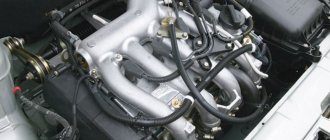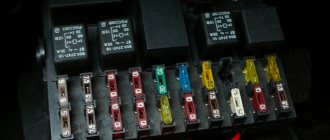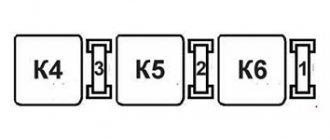When the cold season sets in, the car owner often discovers that the air temperature control system in the cabin of the VAZ 2110-12 does not function normally. The stove either blows cold air or operates at maximum heat output. Both options do not allow you to create a comfortable environment inside the car; in addition, at low air temperatures, the windows may fog up, which makes driving unsafe. You can solve the problem yourself if you know how to do it.
Stove control unit
The control unit for the stove or heater, call it what you want, is located on the center console of the VAZ 2110-2112 car and is responsible for the normal functioning of the temperature regime inside the cabin.
If it malfunctions, it may happen that switching the handles will not give any reaction, accordingly, even at the maximum set temperature - only cold air can blow. If a similar problem is observed with the stove block, then this part must be replaced. To do this, just have a couple of screwdrivers on hand, preferably with a flat blade and as thin as possible.
Removing the temperature controller
To repair or replace the stove temperature regulator, you need:
- Unscrew and move to the side one of the climate dampers located under the steering wheel of the car.
- Next, the pedal assembly, consisting of the brake pedal and gas pedal, is dismantled. The wiring harness is disconnected from the assembly, and the connectors are disconnected from the pedals.
- Two connectors are unfastened from the heater regulator, and its contacts are diagnosed - maybe they are oxidized or burnt.
- At the final stage, the temperature regulator is unscrewed, which is held on by a pair of screws.
This completes the work on removing the regulator.
Source
Causes of unit malfunction
Engineers began to use a similar method of adjusting temperature and air direction back in the early decades. Since then, this system has been improved, and is already used on new models of the AvtoVAZ plant. Despite its rather simple design, the stove control unit periodically fails. There are several reasons for this:
- damage to mechanical parts in the structure;
- break in the power supply circuit of the unit;
- damper jamming.
To repair or replace the unit, you will need to dismantle the faulty module. For its time, this stove control design was considered truly innovative (at least for domestic cars), while now it fails more and more often. Repairing a block is not the easiest procedure, so more often than not, owners of cars of the “ten” family with such a problem change the block assembly.
Heating and ventilation system on Lada Granta, design
- radiator;
- several air ducts: to the glass blower grilles, to the right, central and left deflectors;
- Control block;
- radiator cap;
- air duct;
- seal;
- stove body;
- a hole connecting the air duct to the rear passengers;
- fan;
- fan housing;
- damper drafts: recirculation, temperature controller, air flow distribution;
- Fan resistor is optional.
Replacing the heater controller
For normal access to the block structure, it must be dismantled. The work to remove the ACS unit is carried out as follows:
- First of all, use one screwdriver to pry the module on the right side so that it comes out a little.
- Then we perform exactly the same actions, but on the left side.
- We carefully pull out the block by hand until we see the plug for connecting it, which fits to the back side of the stove block. The photo below shows this more clearly.
We remind you
that while performing this work, it is worth turning off the power to the vehicle in order to avoid short circuits or damage to the electrical equipment of the VAZ 2110-2112.
- If, when connecting a known working unit, there is no change in the operation of the stove, you should check the condition of the wiring.
- If there is a weak flow of warm air even in the maximum “warm” position of the stove, check the level of antifreeze in the tank.
Source
Problems with the VAZ 2112 stove and its repair
The design of the VAZ 2112 stove heater differs from the previous VAZ-2108, 2109 family. When the engine is running, the radiator temperature should correspond to the general temperature of the cooling system. This means that the damper is always open and the supply of antifreeze (antifreeze) does not stop. The control system is electrical; processes are controlled by electronic sensors and controllers.
The center console has two control levers and one regulator. The driver, as necessary, sets the air temperature in the cabin, activates the desired mode (speed) of the fan, and directs the air flow to heat the glass and legs. A special electric thermometer installed in the ceiling controls the temperature. As soon as the temperature drops, the controller transmits a signal to the micromotor reducer, the heater is activated, and a flow of warm air enters the cabin. A malfunction of one or more units causes a breakdown, the VAZ 2112 stove does not heat well, and prompt repairs are required.
Characteristic symptoms of malfunctions
In practice, there are five most common signs:
- The VAZ 2112 heater does not work, it constantly rotates at one stable speed;
- Temperature is not adjustable;
- The air flow control flaps are fixed and cannot be adjusted;
- Sensor - regulator on the ceiling is in a faulty state;
- Unstable operation of the ACS controller (automatic heater control system)
- Antifreeze leaking from under the radiator.
The list is not exhaustive, but only indicates the main malfunctions of the VAZ 2112 stove. Prevention will require a visit to a service station followed by diagnostics.
Causes of breakdowns
- violation of the terms of scheduled technical inspection;
- installation of non-original parts, components, consumables;
- filling the cooling system with antifreeze (antifreeze) of low quality or with chemical impurities, the quantitative composition of which exceeds permissible standards;
- mechanical damage to the fluid supply line, accident, collision, impact, violation of installation technology;
- short circuit in the network, electrical circuit, which contributed to the failure of the controller, sensors, resistors;
- damage to the damper control lever, malfunction of the dampers;
- poor terminal contact;
- damage to electrical wiring and cable sections.
Trouble-shooting
Checking the cabin air temperature sensor
You can check the serviceability yourself; special skills are not required. Carefully remove the sensor from its original place. We find the contacts on the back side. Using a multimeter, apply a voltage of 1.2V. We set the regulators of the automatic heater control system to the “Min”, “Max” positions. The motor should not be activated.
The second method is to turn off the cabin air sensor. Check fan speed settings. The first speed (“A”) should be inactive.
Video: Heater VAZ 2110, 11, 12. Design and principle of operation.
Checking the proper operation of the automatic control system
The proper operation is checked with a multimeter. The voltage at the terminals of the pink and brown wires is measured, the ignition is activated. Smoothly turn the temperature regulator; the arrow on the multimeter display should show an increase in voltage.
On old-style heaters, at maximum voltage, the controller value remains unchanged. Take this into account so as not to make hasty conclusions about the malfunction of a particular unit.
The cause of controller malfunction may also be deformed dampers. To verify this and eliminate the breakdown, we disassemble the heater.
Prevention of the damper of the heating system of VAZ 2112
To be precise, two dampers are subject to inspection; this is the number of them present in the VAZ 2112. The cold air intake is regulated in the upper part. In the lower part, warm (hot) air is supplied to the car interior. Due to wear on the drive mechanism, the damper opens halfway or partially, the air flow is reduced, and the interior is not heated sufficiently.
Reasons for failure:
- biting, jamming during operation, due to the lack of a sufficient amount of lubricant;
- a lot of debris, moisture, sand, dirt, which contributed to jamming;
- failure of the gear motor damper cable;
- numerous layers, rust, corrosion.
The control unit of the VAZ 2112 stove must work properly
General view of the control unit for the heater of a VAZ 2112 car
The desired temperature in the cabin is maintained by a heater or stove. The system does not have a valve, which in other models shuts off the flow of coolant. This promotes constant heating of the heater radiator, which speeds up the heating of the interior. The VAZ 2112 stove control unit, built into the heating system, controls the required air heating. At the same time, the deviation of the temperature in the cabin from the set one does not exceed two degrees Celsius. In modern cars, it is increasingly difficult for the driver to find faults in the heating system and fix them with his own hands, without the involvement of specialists. This article suggests getting acquainted with the repair of the heater control unit of a VAZ 2112 car.
Interior ventilation
To ventilate the interior, set the ventilation and heating control unit controls to the following positions.
- Turn control knob 2 to the minimum temperature position (see Fig. 1 and 2).
- Place the regulator handle 4 opposite the pictogram.
- Open the nozzles on the instrument panel.
- Set the desired air supply speed with switch 1.
- If the windshield fogs up, set the regulator handle 4 opposite the pictogram.
Features of the VAZ 2112 heater control unit
The difference between the interior heater of the VAZ 2112 and previously released models is as follows:
- The heater core should always be hot when the engine is running.
- The stove control is completely electronic. It is carried out by the controller with three handles. With its help, you can set any air temperature in the car interior, turn on the desired operating mode of the heater fan, control the air flow - direct it to the windshield up or down to your feet.
- There is a sensor installed on the ceiling that measures the temperature in the cabin.
- The controller receives a command from the sensor, which operates a micromotor gearbox that controls the air damper. At the same time, it directs the air flow through the appropriate channels.
- The operation of the stove in the set mode is checked by inspecting the movement of the air damper when the corresponding handle is turned on the controller. To do this, the central deflectors are removed, and through the resulting hole you can see the operation of the damper.
- If the air damper is not in place, you should first check the temperature sensor located near the ceiling lamp. For this:
- the lamp cover is removed;
- the block with wires is unfastened;
- the unit is changed to a known good one;
- The operation of the damper is checked.
The design of the heating system VAZ 2110-12
The VAZ 2110-12 is equipped with updated climate systems with automatic or manual adjustment of the air temperature in the cabin. They use three main components:
- Temperature sensor.
- A controller or electronic control unit that operates only in automatic mode.
- A micromotor-gearbox, which is an executing device to which controller commands are sent, as a result of which the heater damper moves, forming the air flow.
- Connecting wires and connectors.
When the temperature of the VAZ 2110 stove is not regulated, in most cases problems arise precisely in the heater control system. The sensor is located in the ceiling of the car interior; it sends a signal to the controller located in the cabin to the right of the driver, and the micromotor-gearbox is located in the engine compartment on the heater housing under the plastic windshield trim. It receives a command from the control unit and operates in the specified mode.











